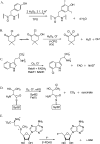Structural perspective on enzymatic halogenation
- PMID: 18774824
- PMCID: PMC3980734
- DOI: 10.1021/ar800088r
Structural perspective on enzymatic halogenation
Abstract
Simple halogen substituents frequently afford key structural features that account for the potency and selectivity of natural products, including antibiotics and hormones. For example, when a single chlorine atom on the antibiotic vancomycin is replaced by hydrogen, the resulting antibacterial activity decreases by up to 70% ( Harris , C. M. ; Kannan , R. ; Kopecka , H. ; Harris , T. M. J. Am. Chem. Soc. 1985 , 107 , 6652 - 6658 ). This Account analyzes how structure underlies mechanism in halogenases, the molecular machines designed by nature to incorporate halogens into diverse substrates. Traditional synthetic methods of integrating halogens into complex molecules are often complicated by a lack of specificity and regioselectivity. Nature, however, has developed a variety of elegant mechanisms for halogenating specific substrates with both regio- and stereoselectivity. An improved understanding of the biological routes toward halogenation could lead to the development of novel synthetic methods for the creation of new compounds with enhanced functions. Already, researchers have co-opted a fluorinase from the microorganism Streptomyces cattleya to produce (18)F-labeled molecules for use in positron emission tomography (PET) ( Deng , H. ; Cobb , S. L. ; Gee , A. D. ; Lockhart , A. ; Martarello , L. ; McGlinchey , R. P. ; O'Hagan , D. ; Onega , M. Chem. Commun. 2006 , 652 - 654 ). Therefore, the discovery and characterization of naturally occurring enzymatic halogenation mechanisms has become an active area of research. The catalogue of known halogenating enzymes has expanded from the familiar haloperoxidases to include oxygen-dependent enzymes and fluorinases. Recently, the discovery of a nucleophilic halogenase that catalyzes chlorinations has expanded the repertoire of biological halogenation chemistry ( Dong , C. ; Huang , F. ; Deng , H. ; Schaffrath , C. ; Spencer , J. B. ; O'Hagan , D. ; Naismith , J. H. Nature 2004 , 427 , 561 - 565 ). Structural characterization has provided a basis toward a mechanistic understanding of the specificity and chemistry of these enzymes. In particular, the latest crystallographic snapshots of active site architecture and halide binding sites have provided key insights into enzyme catalysis. Herein is a summary of the five classes of halogenases, focusing on the three most recently discovered: flavin-dependent halogenases, non-heme iron-dependent halogenases, and nucleophilic halogenases. Further, the potential roles of halide-binding sites in determining halide selectivity are discussed, as well as whether or not binding-site composition is always a seminal factor for selectivity. Expanding our understanding of the basic chemical principles that dictate the activity of the halogenases will advance both biology and chemistry. A thorough mechanistic analysis will elucidate the biological principles that dictate specificity, and the application of those principles to new synthetic techniques will expand the utility of halogenations in small-molecule development.
Figures



References
-
- Vaillancourt F. H.; Yeh E.; Vosburg D. A.; Garneau-Tsodikova S.; Walsh C. T. Nature’s inventory of halogenation catalysts: Oxidative strategies predominate. Chem. Rev. 2006, 106, 3364–3378. - PubMed
-
- van Pée K. H.; Dong C.; Flecks S.; Naismith J.; Patallo E. P.; Wage T. Biological halogenation has moved far beyond haloperoxidases. Adv. Appl. Microbiol. 2006, 59, 127–157. - PubMed
-
- Anderson J. L.; Chapman S. K. Molecular mechanisms of enzyme-catalysed halogenation. Mol. Biosyst. 2006, 2, 350–357. - PubMed
-
- Neumann C. S.; Fujimori D. G.; Walsh C. T. Halogenation strategies in natural product biosynthesis. Chem. Biol. 2008, 15, 99–109. - PubMed
Publication types
MeSH terms
Substances
Associated data
- Actions
- Actions
- Actions
- Actions
- Actions
- Actions
- Actions
- Actions
- Actions
- Actions
- Actions
Grants and funding
LinkOut - more resources
Full Text Sources
Other Literature Sources

